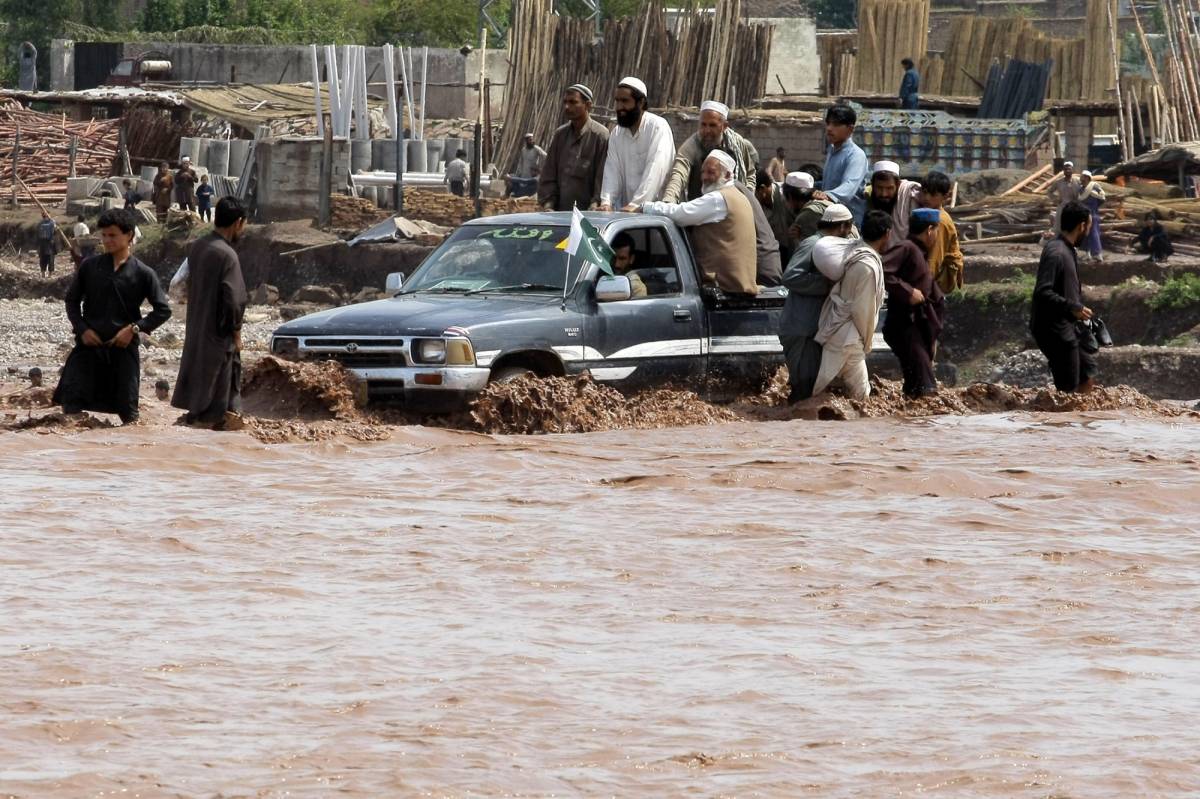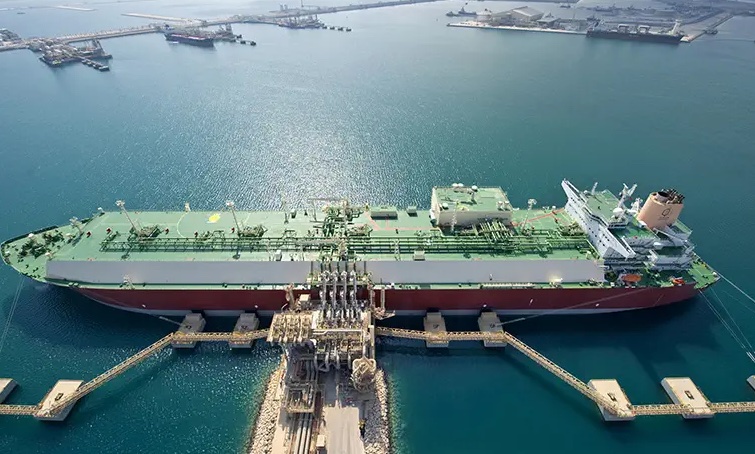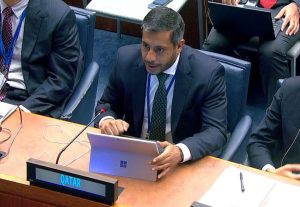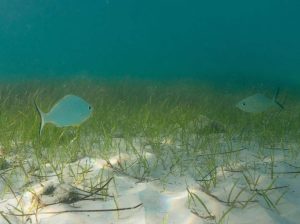A major environmental crisis is looming over Pakistan. The country is highly vulnerable to the impacts of climate change. It is ranked 5th among the most affected in the world. Pakistan is facing the adverse impacts of climate change in the form of melting glaciers, floods, shifting weather patterns and droughts … A special report by Salma Kouser Asif
Pakistan is highly vulnerable to the impacts of climate change. It is ranked 5th among the most affected countries in the world. The country is facing the adverse impacts of climate change in the form of melting glaciers, floods, shifting weather patterns and droughts. Pakistan is also grappling with its worst water crisis and is predicted to suffer from water scarcity by 2040. With rising population only aggravating a fragile situation, the country which was once a water abundant entity is today facing a crisis with acute and frequent droughts. Climate change is likely to further exacerbate this condition.
Recently, the Water and Power Development Authority (WAPDA) of Pakistan reported that the per capita water availability in Pakistan has dropped from 5650 cubic meters in 1951 to 908 cubic meters per annum in 2021.

The main source of water to Pakistan is the Indus River system. The entire country predominantly lies in this basin. More than half of the water in the Indus River is supplied by the melting glaciers of the Hindu Kush – Himalayan mountains. However, global warming and the consequent glacier melting are distressing the water resources on the upper Indus Basin, further upsetting the downstream irrigation projects and other water reserves dependent on it. In fact, the fast-tracked ice melting is predicted to increase the frequency of floods and GLOFs (glacial lake outburst floods) in the region, signs of which are already becoming visible. Such environmental effects could be disastrous for Pakistan where more than 80% of the agriculture is supported by the Indus River Basin and is dependent on water accessibility and irrigation systems.
Under such circumstances, the province of Sindh which originally got its name from the Indus River itself (River Sindhu), may be particularly impacted. The province has the second largest population in the country and is the second largest contributor to the country’s economy. It is situated in an intense heat zone and global warming arising out of infrastructure projects in a sensitive ecological region are likely to significantly affect both its population and agriculture. There would be a substantial decline in the production of Kharif crops like maize, rice, sugarcane, millet and cotton which require a lot of water and other water intensive crops like wheat as well. Since the province also provides its vegetable produce to the rest of the country environmental consequences of ecologically unfriendly projects will impact food availability not just in the province but the entire country as a whole. The fishing industry is also prone to being affected adversely.
The Sindh province accounts for around 70% of the total fisheries of Pakistan. The Indus River system includes a total of 19 barrages for the purpose of irrigation, and three of these are located in the Sindh province -Guddu, Sukkur and Kotri barrages. The availability of the famous Hilsa, locally known as Palla has been decimated due to construction of dams and barrages in the upstream of River Indus for diversion of water for the purpose of irrigation. This has resulted in the Indus delta, which was once a breeding place for the Hilsa fish in not receiving enough freshwater for its breeding and spawning. Previously, the fish would travel up to Multan, however with the construction of these barrages, the migration of the Hilsa fish has drastically declined and with the Kotri barrage their spawning area has also been severely reduced.
These risks are bound to be further aggravated by the construction activities being undertaken in the Hindukush Mountain region. As is known, Pakistan is projected to face acute water scarcity. The continued demand for water against the already declining resources could also be a potential cause of concern for Pakistan vis-a vis its neighbours.
This has aggravated the woes of the fishing community in the region. The reduced discharge of the fresh water into the sea is proving to be disadvantageous for the breeding of the fish and shrimp as these species primarily rely on fresh water with low salinity for their growth.
Sindh is also characterized by another famous aquatic entity popularly known as the Indus River dolphins. In fact, the Guddu and Sukkur barrages have the highest density, close to 90% of the total population of the Indus River dolphins. These dolphins being the most endangered river dolphin species in the world with a population of around 1200 have resulted in these barrages being recognized as Indus River dolphin reserves under the Sindh wildlife law. Sadly however, the construction of barrages and dams on the Indus River has substantially brought down the population of these dolphins as their natural habitat has been systemically dented.

Further, the rise in the sea level as a consequence of global warming is causing seawater intrusion (advancing of the seawater to the river canals) in the Sindh coast. The main reason for this kind of intrusion is understood to be the reduced freshwater discharge due to contracted water flows from the Kotri barrage. With the absence of regular supply of freshwater, saline sea water is percolating into the soil & the aquifers making it unfit for consumption by the human and animal populace as well as for crop cultivation. The construction of dykes in an attempt to halt the intrusion of seawater in the coastal belt has also largely failed as seawater continues to escape into the ground aquifers. This has extensively contributed towards the degradation of the land and water resources in the Sindh province. More specifically, the worst affected districts due to sea intrusion are Thatta and Badin districts, inundating about 1.2 million acres of land in the coastal areas. All this has also resulted in forced migration to already burdened cities like Karachi and other urban areas in Pakistan in search of livelihood and means to overcome poverty.
In fact, the Indus Delta being one of the largest deltas in the world is blessed with thick mangrove forests. A beautiful natural phenomenon it is the deposition of water, nutrients and silt carried by the Indus River that sustains these forests. (Waqar Ahmed and Syed Shahid Shaukat, 2015). Home to many migratory birds, wild life and fish species, they also act as a natural windbreaker and give protection against storms.
With the reduced freshwater flow from the Indus River these mangrove forests have drastically reduced in the Sindh province. Traditionally, mangroves have been a valuable resource for the villages situated in the coastal areas as the coastal population is dependent upon them for their livelihood. But with receding mangroves, the situation is fast deteriorating.
There is an immediate need for Pakistan to pay attention to its water management – firstly, to avoid droughts and floods and secondly, to lower the chances of another latent cause of tension in the neighbourhood. How it engages with environmental issues in general, and the CPEC issue in particular is going to be extremely important in the times to come
Contributing to this existential threat of climate change, Pakistan’s foreign policy and developmental trajectory too are adversely influencing the Sindh region and the economic and ecosystem services that it sustains on. For example, the impact of projects under the China-Pakistan Economic Corridor (CPEC) has the capacity of snowballing into environmental disasters. Around 75 percent of the newly planned energy projects under CPEC are supported by the coal powered plants (Thar-I and Thar-II coal plants) located in the Sindh Province. Apart from playing a part in increasing the carbon emissions it is also largely responsible for seasonal smog that has been reported in Sindh and the neighboring Punjab province. The situation is likely to further worsen when the coal power plants become fully operational.
It is hardly a secret that the Punjab-backed bureaucrats connive with the IRSA (Indus River System Authority), the regulator of Indus waters in Pakistan and the WAPDA to get more than the approved share of allocated water for their province. As per the Water Apportionment Accord of 1991, 37% water share was settled each for Punjab and Sindh and the rest was to be distributed between Balochistan and Khyber Pakhtunkhwa. However, this accord is continually disregarded, and Sindh faults the Punjab province for not releasing the agreed allocated water share to them. This issue has been perennially plaguing the Pakistani government from more than a decade.

However, irrespective of Sindh voicing out its genuine concerns, the ruling party and politicians at the Centre have largely favoured the Punjab province, when it comes to allocation of fair share of Indus waters, owing to the dominance of this region in the nation’s polity. For instance, in May 2021, the IRSA had suspended the water supply from Mangla dam to the Sindh province citing low water level. Punjab, meanwhile continued to receive water from the Taunsa-Punjnad Canal. Interestingly, the yearly rainfall in the Punjab province is always more than what Sindh receives. Hence the groundwater table of Punjab is not as bad as in Sindh.
Nevertheless, this did not deter the authorities from giving concessions to Punjab. Instead, Sindh continued to suffer from water shortages and no freshwater was released downstream the Kotri barrage which is otherwise extremely vital to preserve the Indus Delta.
Admittedly, the Sindh province that is reeling under the impacts of climate change will be further dangerously impacted by the CPEC projects that are capable of disturbing the balance in the Indus River Basin. The upcoming major CPEC projects in the Sindh Province like the Dhabeji Special Economic Zone, Keti Bandar seaport development project, Karachi Circular Railway have the potential to cause environmental hazards, locally resulting in the cutting of trees and augmenting air pollution. The construction of large dams in the province is already being opposed by the people of Sindh. Thus, unless and until the principles of environmental sustainability are applied to the CPEC projects, there is a great risk to the climate and ecosystem balance of the place.
These risks are bound to be further aggravated by the construction activities being undertaken in the Hindukush Mountain region. As is known, Pakistan is projected to face acute water scarcity. The continued demand for water against the already declining resources could also be a potential cause of concern for Pakistan vis-a vis its neighbours. There is an immediate need for Pakistan to pay attention to its water management – firstly, to avoid droughts and floods and secondly, to lower the chances of another latent cause of tension in the neighbourhood. How it engages with environmental issues in general, and the CPEC issue in particular, is going to be extremely important in the times to come.
READ MORE: Protests in Pakistan over China-backed Sindh projects
READ MORE: Imran in a fix over Islamic fundamentalists
READ MORE: World Sindhi Congress condemns Pak’s decision on Diamer-Bhasha Dam













